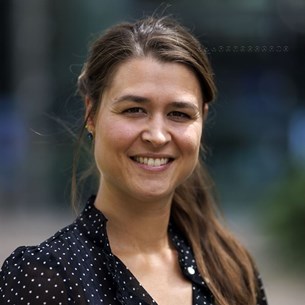Meeting
2022 ASCO Annual Meeting

Erasmus MC Cancer Institute, Rotterdam, Netherlands
Debbie Robbrecht , Bernard Doger , Jean-Jacques Grob , Oliver Edgar Bechter , Maria J. de Miguel , Maria Vieito , Dirk Schadendorf , Giuseppe Curigliano , Ivan Borbath , Marcus O. Butler , Alejo Rodriguez-Vida , Wilson H. Miller Jr., Tun Tun Lin , Nina Masson , Clemence Pouzin , Rui Wang , Brigitte Demers , Amele Amrate , Giovanni Abbadessa , Matteo Simonelli
Background: SAR439459 (SAR459) is a human anti-TGFβ monoclonal antibody that neutralizes all isoforms of TGFβ. In preclinical models, combining SAR459 with an anti-PD-1 showed improved anti-tumor activity compared to SAR459 single agent. In the dose escalation, acceptable tolerability was observed, the MTD was not reached and the preliminary RP2D was 22.5mg/kg Q3W when combined with cemiplimab (CEMI; S. Williamson et al. J Clin Oncol 39, 2021[suppl 15; #2510]). Reduction of plasma TGFβ was ≥90% at doses ≥0.25mg/kg Q2W, with a trend of a decrease in intra-tumoral TGFβ (D. Robbrecht et al. JITC 2021;9 [suppl 2; #250]). Here we report safety and efficacy results of the dose expansion. Methods: The expansion phase of this open-label, phase 1/1b study aimed to determine the optimal dose of SAR459 (7.5 mg/kg or 22.5 mg/kg Q3W) in patients (pts) with advanced melanoma (MEL) resistant to anti-PD(L)1 therapy (Part 2A); and the ORR (confirmed responses) in all treated pts with SAR459 22.5 mg/kg + CEMI 350 mg Q3W in pts with MEL, Non-small Cell Lung Cancer (NSCLC), or Hepatocellular Carcinoma (HCC), resistant to anti-PD(L)1; as well as in pts with mesenchymal Colorectal Cancer (CRC) or Urothelial Cancer (UC), anti-PD(L)1 naïve (Part 2B). Results: From October 2019 to September 2021, 109 pts with ECOG PS 0-1 enrolled in Part 2A (14) and Part 2B (95). Overall, the median age was 63 years and 83% of pts received up to 3 prior treatment lines for advanced disease (range 1-8). Based on preliminary data, the ORR in Part 2B was 8% (Table). No significant association between clinical response and plasma TGFb level at baseline or modulation upon treatment was observed. The correlation between tumor TGFb level and clinical benefit is inconclusive due to limited number of tumor biopsies. No response was observed in Part 2A. Overall, 100% of pts had at least one treatment emergent adverse event (AE), 67% were G≥3, 34% related G≥3, 17% G5, and 4% related G5. The limited number of patients treated with SAR459 alone at the RP2D did not allow to demonstrate added toxicity due to the combination. Overall, 51 pts (47%) reported hemorrhagic AE of any grade, 8 pts (7%) had G≥3 and 5 pts (5%) had fatal outcome. The rate of bleeding and severe hemorrhagic AE was higher in HCC pts compared to the other cohorts: 11/14 (79%) pts had a hemorrhagic AE, of which 3 (21%) G≥3 and fatal. An exploratory analysis showed a trend for higher frequency of any grade SAR459-related and fatal hemorrhagic AE in patients with higher exposure. Conclusions: The NCT03192345 study was discontinued due to a lack of efficacy, and a high bleeding risk particularly in pts with HCC. Clinical trial information: NCT03192345.
| MEL | NSCLC | HCC | CRC | UC | Part 2B all cohorts | |
|---|---|---|---|---|---|---|
| N | 25 | 17 | 14 | 24 | 15 | 95 |
| ORR n(%) | 2(8) | 1(6) | 1(7) | 1(4) | 3(20) | 8(8) |
| PR | 2 | 1 | 1 | 1 | 3 | 8 |
| SD | 6 | 7 | 4 | 5 | 3 | 25 |
| PD | 16 | 7 | 6 | 16 | 9 | 54 |
| Not evaluable | 1 | 2 | 3 | 2 | 0 | 8 |
Disclaimer
This material on this page is ©2024 American Society of Clinical Oncology, all rights reserved. Licensing available upon request. For more information, please contact licensing@asco.org
2022 ASCO Annual Meeting
Poster Session
Developmental Therapeutics—Immunotherapy
Developmental Therapeutics—Immunotherapy
Antibodies
NCT03192345
J Clin Oncol 40, 2022 (suppl 16; abstr 2524)
10.1200/JCO.2022.40.16_suppl.2524
2524
180
Abstract Disclosures
2024 ASCO Annual Meeting
First Author: Gerald Steven Falchook
2024 ASCO Annual Meeting
First Author: Jun Zhao
2021 ASCO Annual Meeting
First Author: Thorsten Oliver Goetze
2023 ASCO Annual Meeting
First Author: Dirk Schadendorf